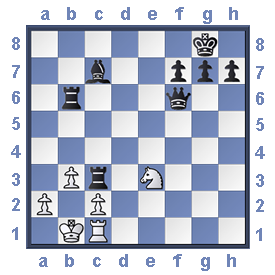It is possible to make a move which attacks more than one piece at the same time. This kind of attack can be very powerful, as the following examples show.
Set up your chessboard and consider the moves. The tangible experience of 'real' pieces will help you spot these possibilities when you play games. your chessboard and consider the moves. The tangible experience of 'real' pieces will help you spot these possibilities when you play games.
Looking at chess positions is far more valuable if you engage as many parts of you brain as possible.
Therefore physically having the board set up, looking at the diagrams and writing down the moves should all be employed when you are studying strategy.
|
| . If White moves his knight to the d5 square it attacks four Black pieces at once. |
 |
White moves N-d5 .
Black to move. As he may only move one piece to safety it is clear that White is going to be able to capture one of the other three pieces on his next move.
It is unusual to have four pieces attacked at once in a game but not impossible. What is common on a chessboard, though, and often seen, is one piece attacking two enemy pieces at the same time.
This is why this attack is called DOUBLE ATTACK or FORK |
 |
| If the White pawn on d4 is moved one square forward it will fork the two Black Pieces. |
 |
| White moves d4 the Black Rook and Knight have been FORKED. |
 |
Black moves his Rook to safety (..... R-h6).
|
 |
| White captures the Knight, victim of a Pawn Fork .(dxc6). |
 |
The piece that is the master of 'forking' is the Knight. His ability to attack several pieces at once makes the strongest players nervous.
|
 |
N-d5 +
The White Knight moves to d5 checking the King and attacking the Queen .
Black must get out of check.
He can only move his King, leaving the Queen to be captured on White's next move. |
 |
 |
.....R-d4.
The Black Rook is now attacking the White Knight and The White Bishop at the same time.
It is and as he may only move one piece to safety, the other is lost. |
 |
| B-e7. White moves his Bishop to safety but his Knight remains attacked and may be captured. |
 |
| ..RxN The Knight is captured and removed from the chessboard, a victim of the fork. |
 |
| The Black Bishop attacks the White Rook and the White Knight only one can move to safety, and the other remains to be captured. |
 |
White has moved his Queen to the e5 square checking the king and forking the Black Rook at the same time. The King must move and so the Rook will be captured.
|
 |
| If the queen moves the Black Rook is captured. If after the capture of the Rook the Queen captures the White Knight then clearly White benefits because the rook (value 5 pawns) is of more value than the Knight (value 3 Pawns). |
 |
In this case though the fork would not be quite so strong . Black will move his Queen away but at the same time defend his Bishop.
So, if the Knight then captures the Bishop and the Queen then recaptures the Knight the exchange is equal- both the Bishop and Knight being worth 3 Pawns each. |
 |
| |
|






 your chessboard and consider the moves. The tangible experience of 'real' pieces will help you spot these possibilities when you play games.
your chessboard and consider the moves. The tangible experience of 'real' pieces will help you spot these possibilities when you play games.















 DISCLAIMER: The information given in this site is presented in good faith, but the site-author is human and does make mistakes! Should you find anything that you believe is in error please notify the Webmaster of your finding.
DISCLAIMER: The information given in this site is presented in good faith, but the site-author is human and does make mistakes! Should you find anything that you believe is in error please notify the Webmaster of your finding.